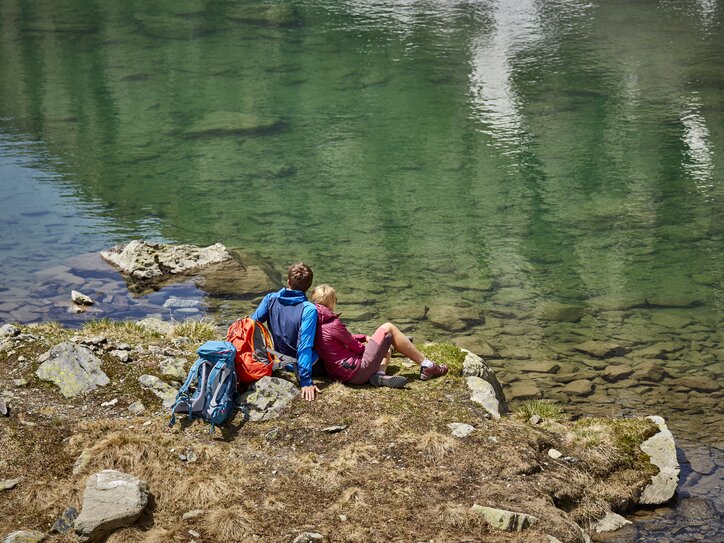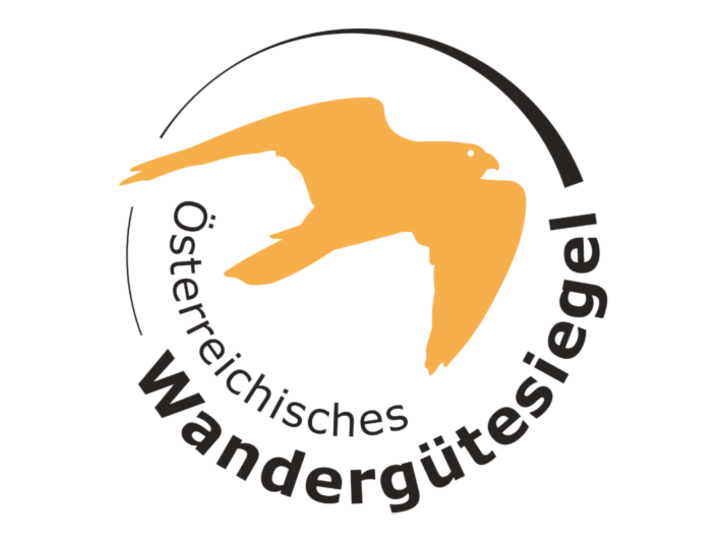The Paznaun High Route
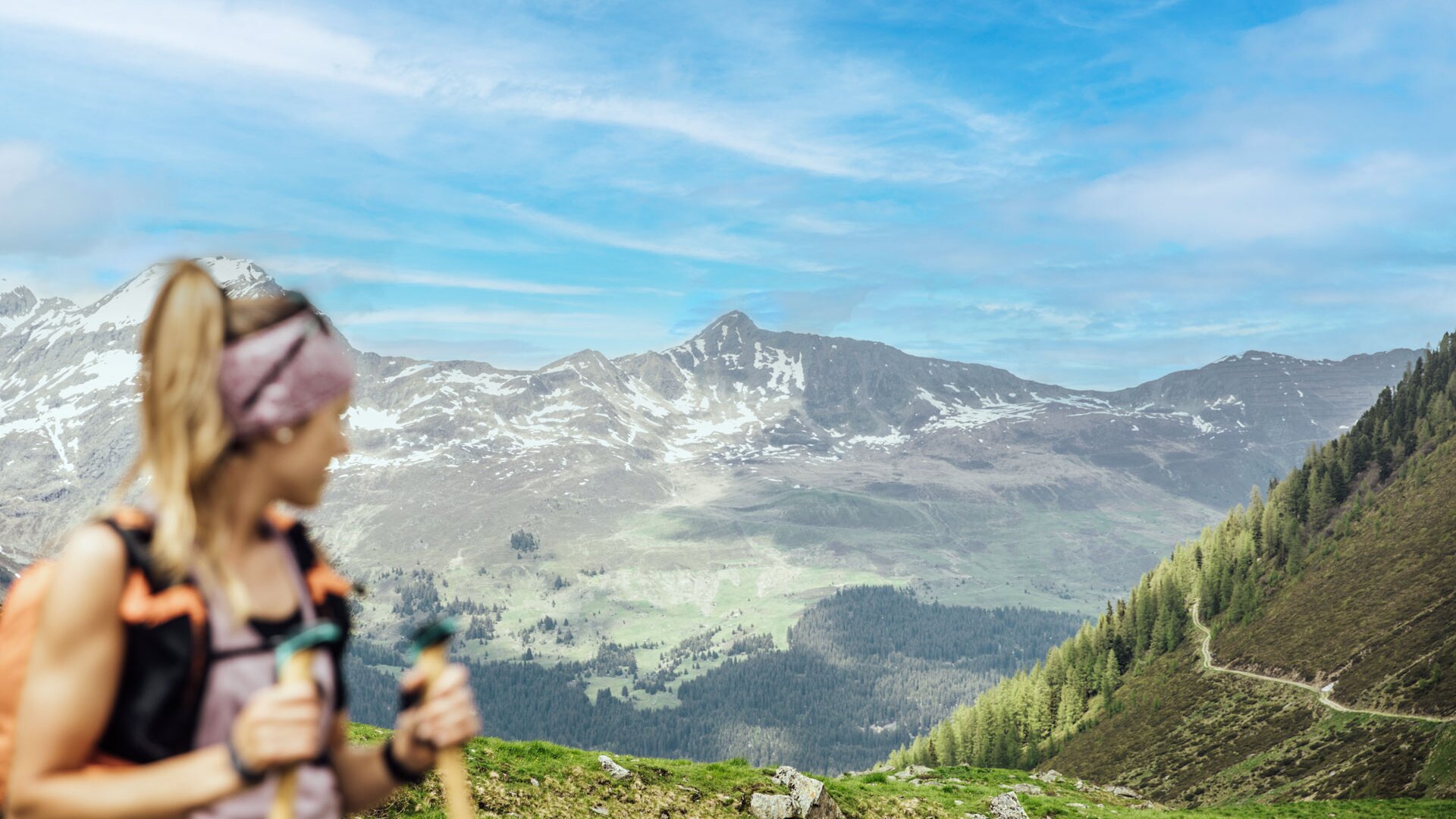



NIne stages, one adventure
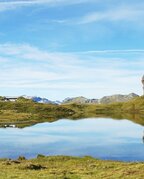
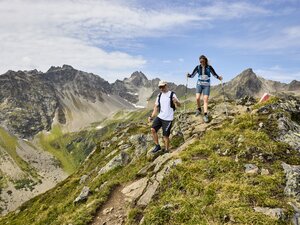
Varied trails and fascinating views of mountains and valleys: The Paznaun High Route is every hiking fan’s dream come true. The long-distance hiking trail is known for its great variety, making it popular with outdoor enthusiasts from all over the world.
The route takes you past lush green Alpine pastures, through the romantic larch forests of the Lower Paznaun Valley and up to high-alpine territory with steep and rocky sections. If you want to explore the Paznaun valley at your own pace, don’t miss this great opportunity to experience 130 kilometres of pure hiking bliss!
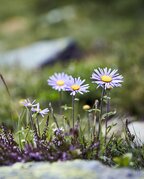


All Stages
Hikers can look forward to trails of varying characteristics and breathtaking panoramic views. The lush alpine meadows and romantic larch forests of the lower valley at the start of the trail will make your heart beat faster, as will the steep and rocky sections in the high alpine terrain of the upper valley. These lead past rugged peaks and rock formations and turn the trail into a real adventure.
Stage 1
The Paznaun High Route starts at the parish church of See and follows the asphalt path to the fork in the path at Giggl. From there, follow the easy trail to Giggler Alm at 1,845 metres above sea level, where you can enjoy splendid views. From Giggler Alm, the trail runs through larch forests and across steep sections, taking you to the finish of the first stage, Ascher Hütte lodge at 2,256 metres above sea level.
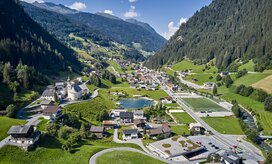
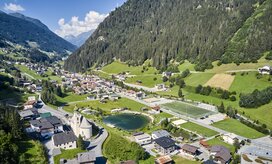
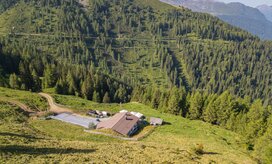
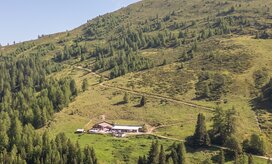
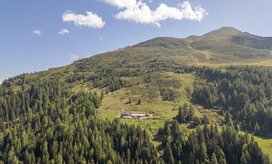
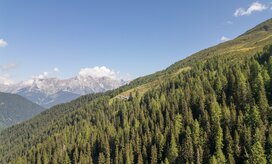
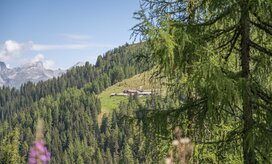
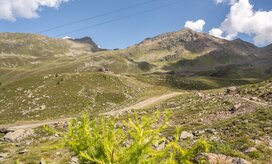
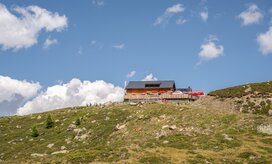
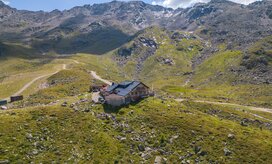
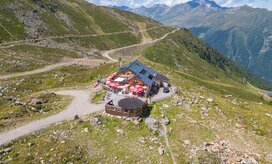
Stage 2
From Ascher Hütte lodge, follow the trail via Medrig to Gratli, where the marked footpath along Istalanz valley and Berglialpe starts. Following a challenging section, you will reach the remote Stielalpe at 2,050 metres above sea level. From there, continue further into the Flath valley and towards Gamperthunalpe lodge at 2,070 metres above sea level. Afterwards, take the trail to picturesque Lake Grübelesee or follow the footpath down to the valley until you reach the Panoramic Trail to Kappl.
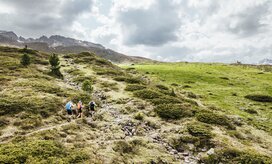
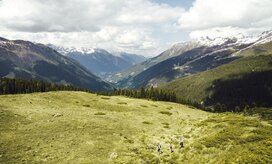
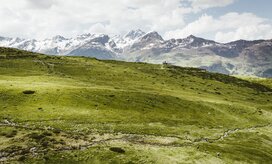
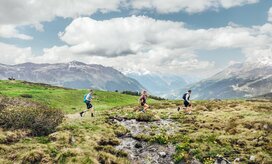
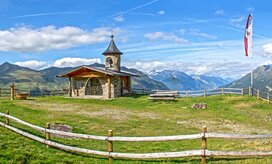
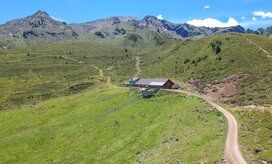
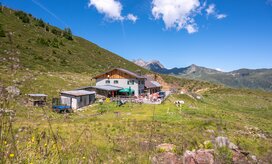
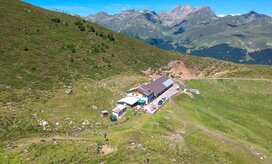
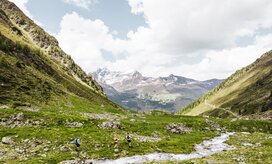
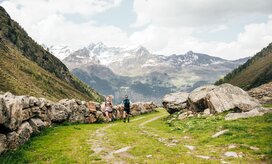
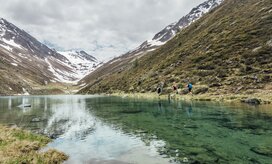
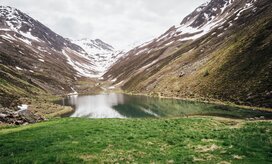
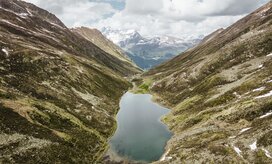
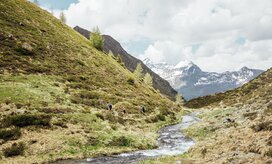
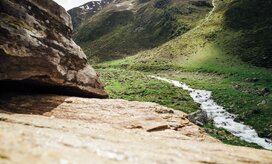
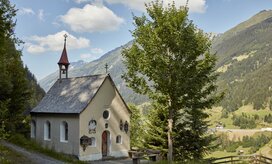
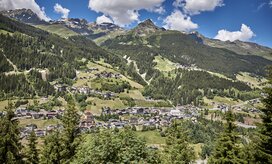
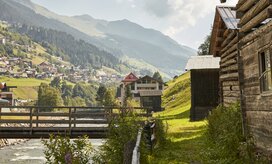
stage 3
From the valley station of Diasbahn cable car, follow the trail towards Samnaun, passing through the forest up to Visnitz Alpe lodge. From there, follow the historic Smugglers’ Trail to eastern Visnitzjoch and towards Switzerland, where you can use chairlifts and cable cars to get back down to the valley and Ischgl. If you prefer to get back to the valley on foot, follow the marked trails around Mullersattel and down to Ischgl.
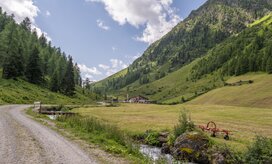
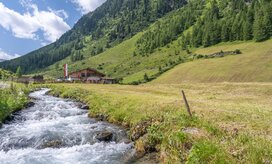
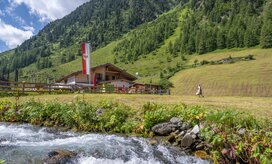
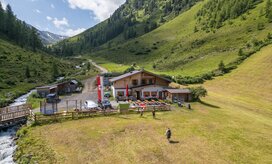
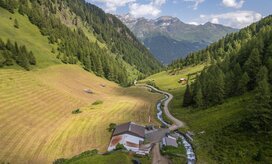
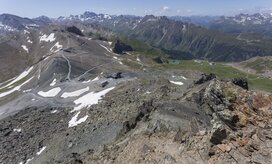
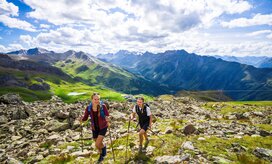
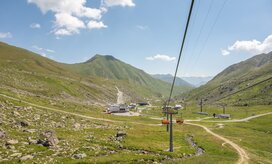
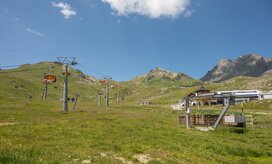
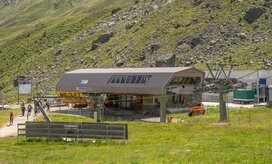
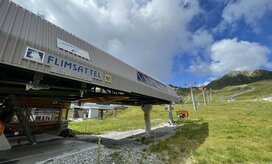
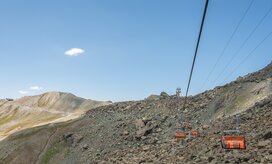
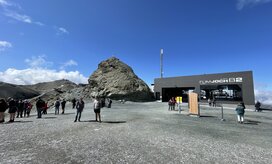
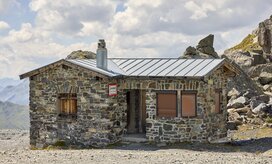
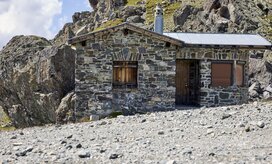
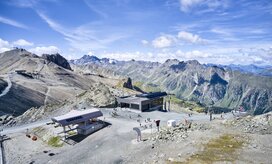
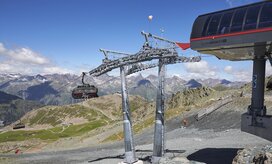
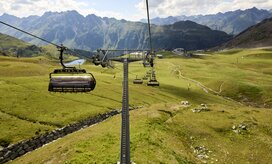
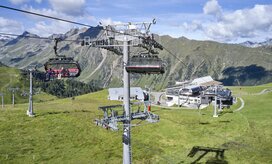
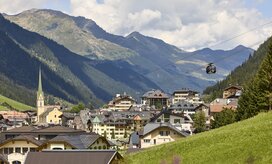
stage 4
From the valley station of Diasbahn cable car, follow the trail towards Samnaun, passing through the forest up to Visnitz Alpe lodge. From there, follow the historic Smugglers’ Trail to eastern Visnitzjoch and towards Switzerland, where you can use chairlifts and cable cars to get back down to the valley and Ischgl. If you prefer to get back to the valley on foot, follow the marked trails around Mullersattel and down to Ischgl.
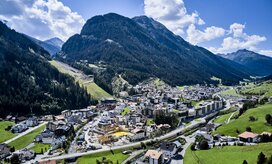
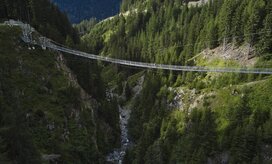
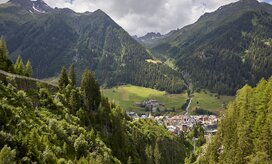

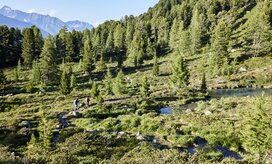
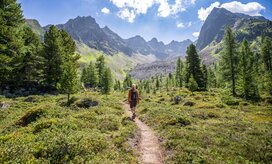
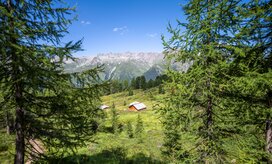
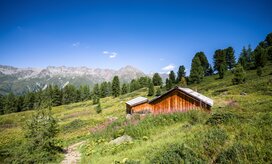
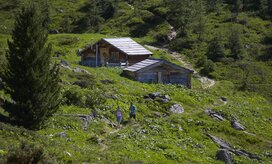
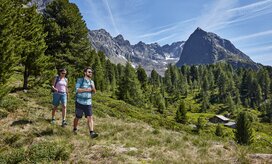
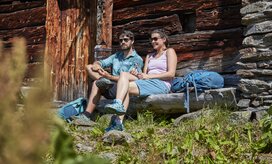
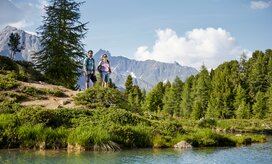
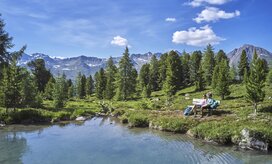
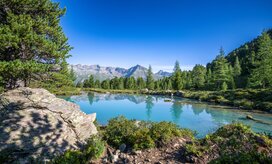
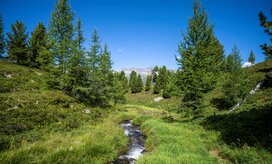
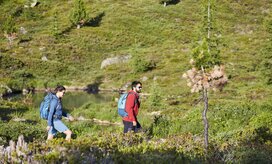
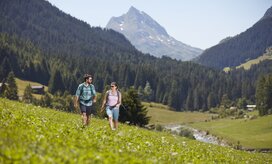
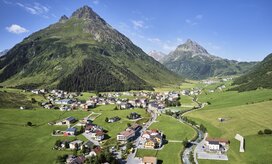
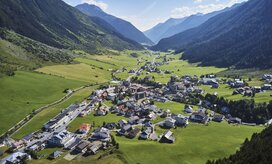
stage 5
Stage 5 of the trail takes about 3.5 hours. After covering 850 vertical metres, you reach Friedrichshafener Hütte lodge at 2,138 metres above sea level. The trail runs from Galtür towards Außertschafein. From there, follow the partly challenging trail with information boards about the local vegetation, forestry management and torrent control.
After the uphill section, you are rewarded with great panoramic views of the Samnaun mountains. After passing the ridge of Adamsberg at about 2,330 metres above sea level, follow the easy trail to Friedrichshafener Hütte lodge.
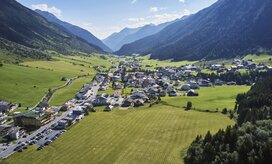
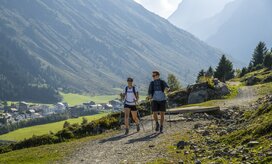
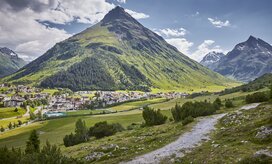
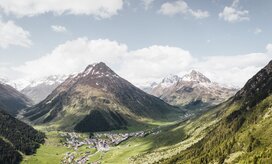
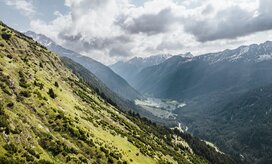
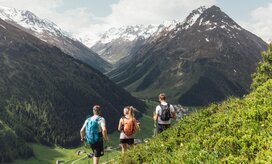
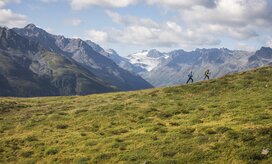
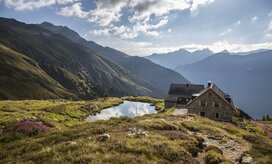
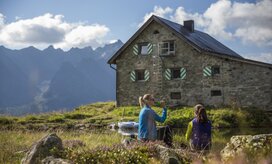
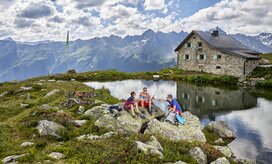
stage 6
The route starts at the Friedrichshafener Hütte lodge and leads over the Schafbichljoch at an altitude of 2,636 metres. It follows the Fasulbach stream down into the valley between the impressive peaks of the Patteriol (3,056 m), the Kuchenspitze (3,151 m) and the Küchlspitze (3,147 m). Before reaching the Konstanzer Hütte lodge, the route climbs up to the Kuchenjöchli at 2,730 m before beginning the descent via the Apothekerweg to the Darmstädter Hütte lodge.
Alpine variant: The "Ludwig Dürr Trail" leads via the Muttenalpe and the Lumpaschadseele to the Dürrschartli at 2,666 metres. After 3.7 km over high alpine terrain with scree and snowfields, the trail leads over the Schönpleispass to the intermediate ridge at 2,770 metres. This is followed by snowfields and steep passages up to the Rautejoch at 2,752 m before the trail descends to the Darmstädter Hütte.
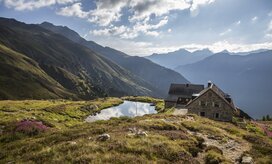
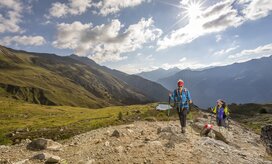
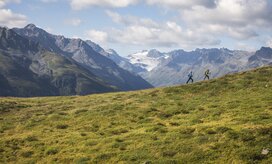
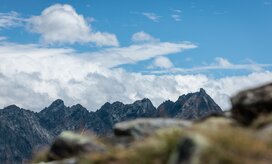
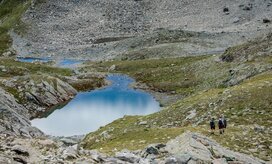
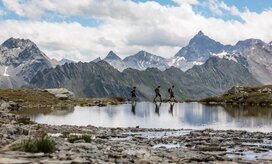
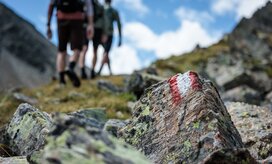
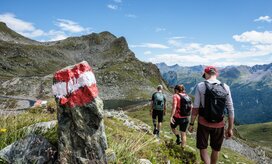
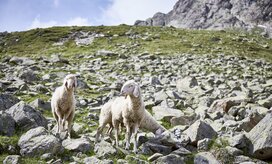
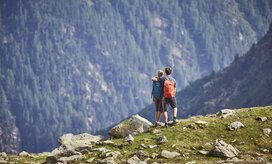
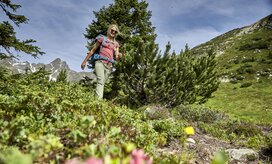
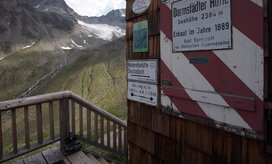
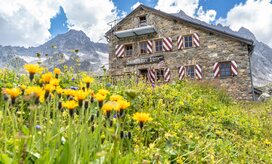
stage 7
The hike from the Darmstädter Hütte lodge into the Moostal valley offers impressive views early on and leads along the shimmering blue reservoir to the Kartellhütte lodge. The Sepp Jöchler Trail climbs up to the Seßladjöchli (2,749 m), framed by the Seßlad and Ruggelkopf peaks, before descending to the Niederelbehütte lodge. The path is steep at first, then over scree and snow fields, but becomes gentler at the green mountain meadows, ending at the picturesque Seßsee lake.
Alpine variant: The route from the Darmstädter Hütte lodge via the Advokatenweg to the Schneidjöchli (2,841 m) and via the Hoppe-Seyler-Weg into the Vergrößkar, past the Fatlarspitze to the Kieler Wetterhütte (2,800 m), offers a more challenging route with a marked descent to the Niederelbehütte lodge.

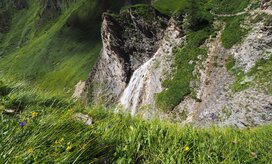
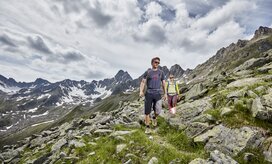
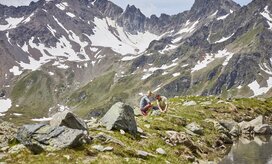
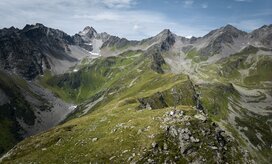
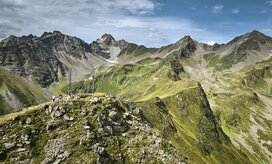

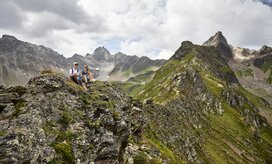
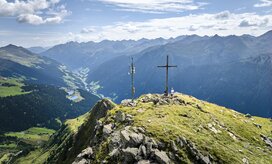
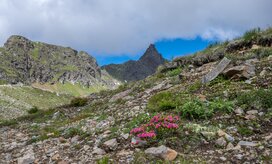
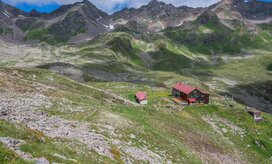
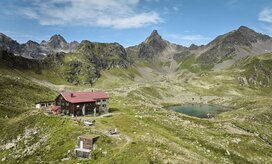
stage 8
From Niederelbehütte lodge, the trail runs to Obere Seßladalpe and further along the picturesque Kieler Weg Trail. It takes you through Kappl ski resort and across Diasalpe. After a steep ascent to Schmalzgrubenscharte at 2,697 metres above sea level, continue along the downhill trail to the romantic Schmalzgruben lakes. After the lakes, continue downhill along Rifflerweg Trail to get to the end of the stage, Edmund-Graf-Hütte lodge at 2,375 metres above sea level.
Time, fitness and weather permitting, you can hike up to Hohe Riffler at 3,168 metres above sea level from Edmund-Graf-Hütte lodge (approximately 2.5 hours walking time).
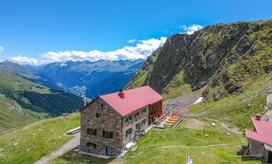
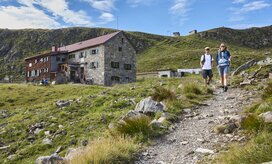
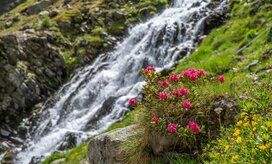
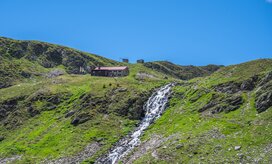
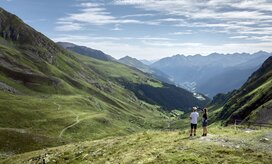
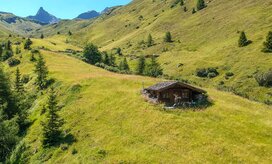
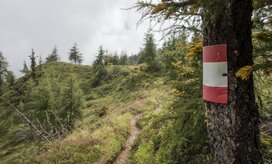
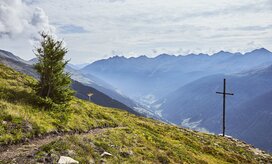
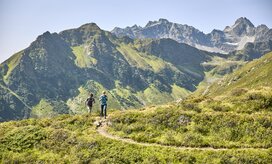
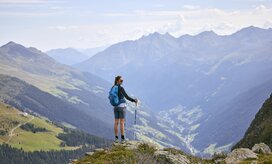
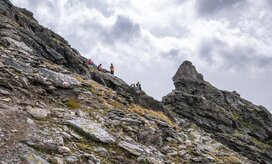
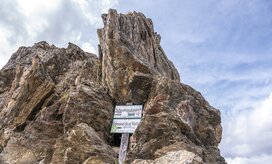
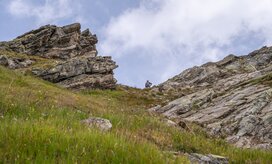
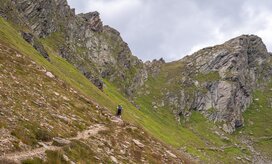
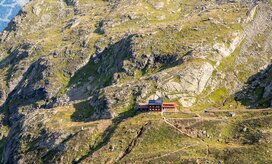
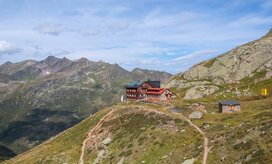
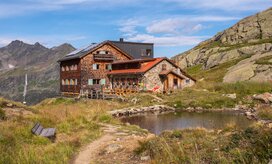
stage 9
From Edmund-Graf-Hütte lodge, the trail takes you up to Kappler Joch at 2,672 metres above sea level. From there, you can see the completed stages of the High Route on the opposite side of the valley. Continue towards picturesque Lake Blankasee and Durrichalpe. The climb up to Spiduralpe (2,120 metres above sea level) and Niederjöchl (2,346 metres above sea level) is rewarded with some perfect spots for a break. From there, the trail runs up to a gorgeous ridge towards Pezinerspitze at 2,550 metres above sea level – an amazing vantage point. From there, continue downhill along the north face, looking towards Strengen in the Stanzer valley until you reach the end of the final stage in See.
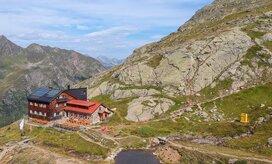
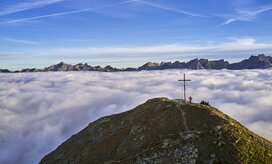
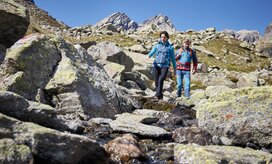
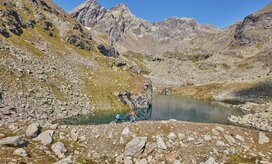
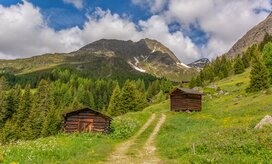
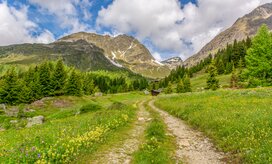
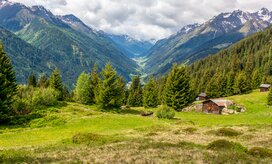
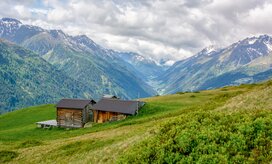
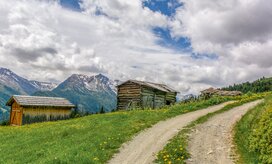
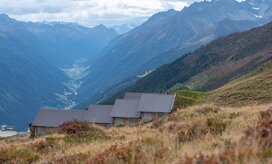
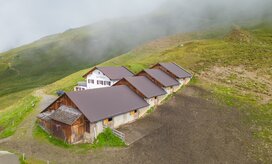
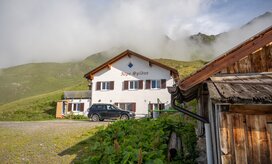
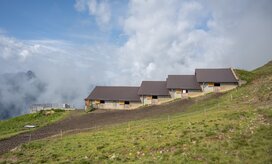
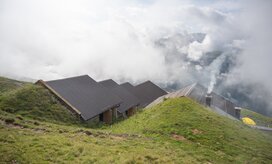
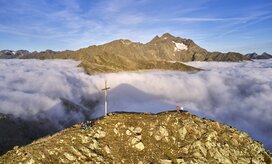
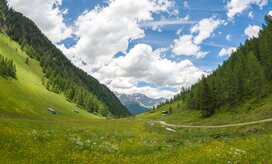
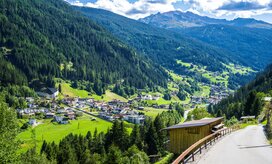
Important tips and information
- Starts/ends in: See
- Total distance: 131 km
- Stages: 9
- Altitude difference: 11,000 vertical metres
The High Route starts in See and takes you further into the valley along the alpine terrain high above the villages of Kappl and Ischgl. Once you have reached Galtür, the trail loops back to See along the other side of the valley.
Good to know: The High Route can be done in both directions and in separate sections.
The entire tour is designed to take nine days and is suitable for mountain hikers of average to advanced fitness. Between stages 1 & 2 and 5 to 9, there are no planned or possible descents into the valley, and the mountain lodges at the respective stage destinations serve as bases. For the entire route, five nights are planned in the lodges and four nights in the valley.
The stages with descent into the valley can also be done individually, the following splits are possible:
- Stage 1 & 2
- Stage 3
- Stage 4
- Stage 5 – 9
Tip: The Ascher Hütte lodge (stages 1 & 2) is about an hour's walk from the mountain station of the Medrigjochbahn in See and the Friedrichshafener Hütte lodge (stages 5 & 6) about an hour's walk from Galtür and Mathon, so you can descend at these two mountain lodges if you wish.
To fuel up during your hike, numerous mountain lodges and restaurants along the way offer traditional and modern delicacies.
In addition to tasty food and drinks, the mountain lodge hosts will also be happy to supply you with useful tips for your tour planning.
The mountain lodges at the end of the stages (on the mountain) offer overnight accommodation as well as food and drink. Important: Check in advance whether the mountain lodges have vacancies for your preferred dates!
All mountain lodges at a glance:
- Ascher Hütte lodge (stage finish/start)
- Alpe Gamperthun lodge
- Visnitz Alpe lodge
- Alp Bella lodge (CH)
- Alpenhaus mountain restaurant/Vider Alp lodge
- Larein Alpe lodge
- Friedrichshafener Hütte lodge (stage finish/start)
- Darmstädter Hütte lodge (stage finish/start)
- Niederelbehütte lodge (stage finish/start)
- Edmund-Graf-Hütte lodge (stage start/finish)
- Spidur Alpe lodge
The Paznaun High Route stages can be reached safely and efficiently by various means of transport - whether by public and sustainable bus or train, by car or by plane: Paznaun impresses with its ideal transport connections and the well-developed local mobility network.


Book a package
Discover the perfect package for the spectacular Paznaun High Route! The packages include overnight stays in the valley and on the mountain as well as an experienced guide for the planned stages.
You have the choice: a package for beginners with overnight stays in the valley and a hiking starter pack with everything you need, or the package for advanced hikers with overnight stays in the valley and on the mountain and the ascent of 6 stages (depending on the weather).
So go ahead, book now and start your adventure on the Paznaun High Route!


in alpine terrain
Easy Hiking Trails
...are relatively easy hiking & mountain trails that can be narrow and steep. There are no passages with a direct risk of falling.
Intermediate mountain Trails
...are predominantly narrow, often steep and can have passages where there is a risk of falling. There may also be short secured walking passages (e.g. wire rope).
Difficult mountain Trails
...are narrow, often steep and dangerous to fall down. There are frequent secured walking passages and/or easy climbing sections that require the use of hands. Surefootedness and a head for heights are essential.
- Only fit in the mountains and not just "fit through the mountains".
- No mountain hike without careful tour planning.
- Take the right equipment for the planned tour and nothing unnecessary.
- Obtain information about the tour and the weather conditions.
- Take a ten-minute break every two hours.
- Drink and eat plenty during the tour.
- Never leave the marked trail!
- Abort the tour in good time in the event of danger or deteriorating weather conditions.
- Emergency equipment (first aid kit, bivouac sack, torch, mobile phone) belongs in every rucksack.
- In an emergency, stay calm and call the mountain rescue service (Alpine emergency number 140).
- Secure injured persons from falling rocks, falls, avalanches, etc.
- First aid (breathing, circulation, haemostasis, splinting, etc.)
- Protect the injured person from the weather (wind, rain, sun, etc.)
- Never leave the injured person alone. Constant encouragement and support are essential for survival
Alpine distress signal: Repeat a visual or acoustic signal at regular intervals six times a minute - followed by a one-minute pause - until a response is detected.
If it is not possible to raise the alarm for help from the accident site: the signaller descends to fetch help - but never leave the injured person alone! If possible, do not descend alone.
Provide the reporter with the following data in writing: Exact location of the accident, type of injury, number of injured and uninjured group members. Leave unused warm clothing, rain protection and food with the injured person.
As the hiking area stretches across Switzerland, Vorarlberg and Tyrol, you will also encounter different signposting standards. All signs indicate the level of difficulty, destination, walking time and location information. But there are also other country-specific features:
| TYROL The Tyrolean signs also provide information about route numbers and can display further information using pictograms (e.g. restaurant) or themed routes. |
| VORARLBERG Route separators between the destinations indicate turn-off destinations. The location number can be used to provide the exact location in an emergency. |
| SWITZERLAND Different route destinations are subdivided with a route separator. Additional information using pictograms (e.g. railway station). Themed routes can be labelled with route fields. |
Enjoy the marvellous variety of plants in our alpine nature, but please adhere strictly to the legal regulations on the protection of native flora. It is also your responsibility to ensure that no plant species is wiped out and lost for future generations.
| Under protection: | ||||
| Snow rose | Fire lily | Edelweiss | Cochineal | Türkenbund |
| Innsbruck pasque flower | Spring pasque flower | Blue gentian | Long-tubed primrose |
|
Also protected are:
Yellow and black rue, blue and yellow marsh iris, dwarf alpine rose, stemless and glossy-leaved primrose, Baldo anemone, dragon's head, true speik and all alpine cushion and rosette plants.
A maximum of five pieces may be picked from:
Lily of the valley, large snowdrops or spring knot flowers, all columbine species, rock roses, platenigl, dwarf primrose and flour primrose, blue speick, cyclamen or cyclamen, white and yellow alpine anemone and narcissus anemone, all long-stemmed gentians, large-flowered and yellow foxglove.
At most, you may pick a hand bouquet of:
Stonecrop, spring cowslip, centaury, short-stemmed, blue-flowering gentian and alpine aster.
Provided that no damage is caused to the tree by cutting off branches, it is permitted to take a hand bouquet of Swiss stone pine branches.


Tip



The Paznaun
The Paznaun is much more than a simple Alpine valley. Nestled between the Verwall mountains, the Samnaun mountains and the Silvretta mountains, it offers an incredible variety of landscapes with fascinating geology, extraordinary flora and rich wildlife.
In addition to its impressive nature, Paznaun has a long history of colonisation by Rhaeto-Romanic and Walser people, who shaped its present-day culture and traditions. At the same time, the region developed into an important centre for tourism and alpinism, which today attracts outdoor enthusiasts from all over the world.
Whether exploring the unspoilt mountain landscape, observing rare animal species or searching for historical traces - Paznaun is a region full of beauty, history and adventure.
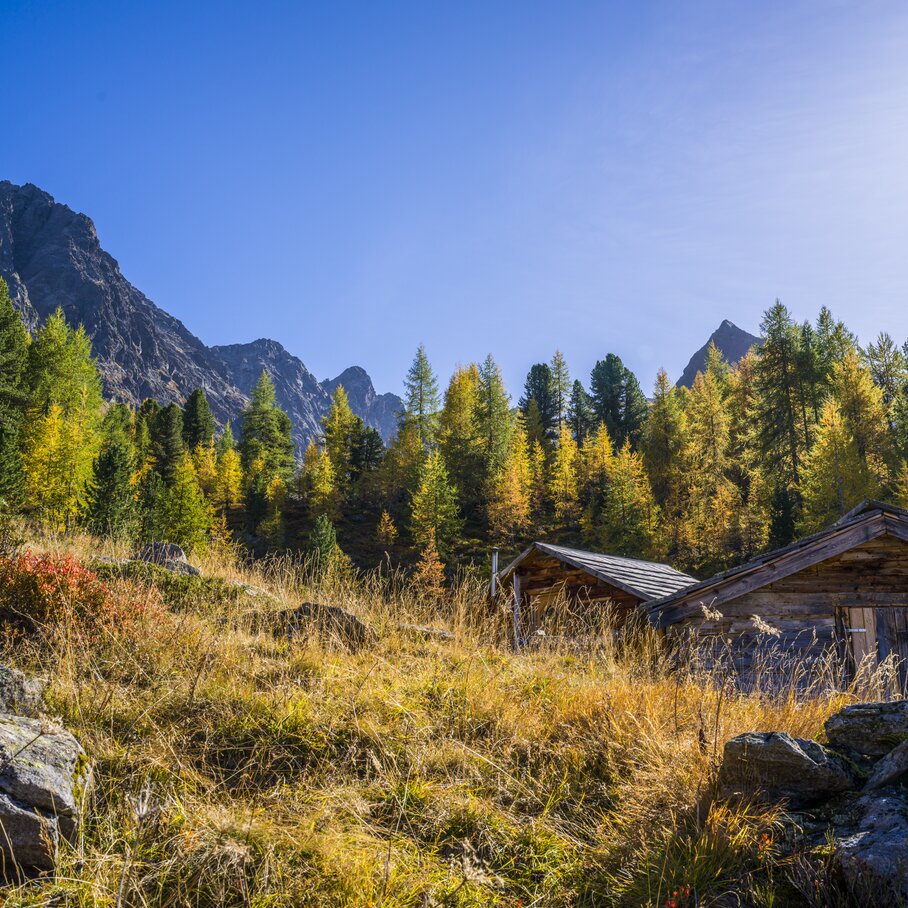
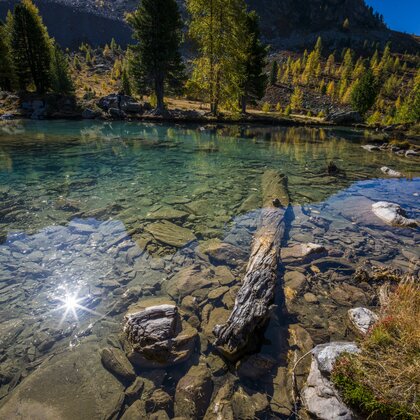


The Paznaun High Trail is certified with the Austrian Hiking Quality Seal
The Austrian Hiking Quality Seal stands for top-tier quality in hiking tourism. It certifies hiking trails, villages, and hosts that create a seamless experience and unforgettable outdoor adventures. The evaluation follows a comprehensive model, considering landscapes, visitor experience, navigation, and infrastructure.
But quality is not a one-time promise: Every four years, certified regions undergo on-site inspections to ensure high standards are maintained and continuously improved.
Certification is also a prerequisite for joining the Austrian Hiking Villages association, which includes over 40 top hiking destinations – from wild alpine landscapes to rolling vineyard hills. Each one is dedicated to the magic of walking, inviting visitors to explore Austria’s beauty step by step.
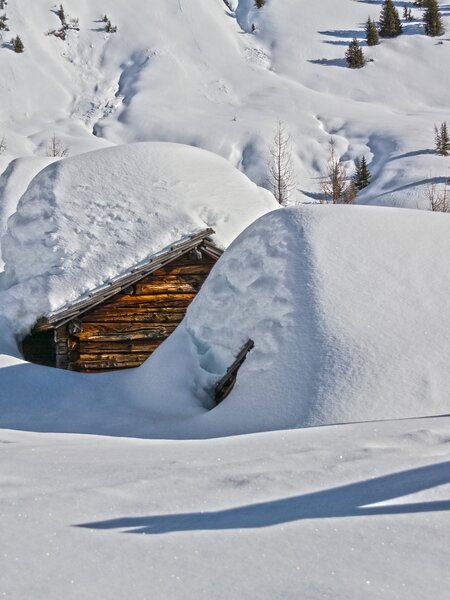
Take part in our survey and with a little luck win a holiday in Austria!
